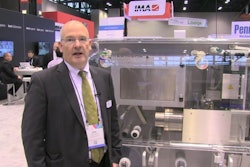
John Kowal, Director, Business Development, B&R Industrial Automation defined the “Internet of Things” (IoT) in the context of pharmaceutical processing and packaging—as well as what it doesn’t mean. He stressed that business data systems and fads have come and gone over the years, often with long-term performance that doesn’t meet the hype. Examples he cited included:
• Dot.com portals
• Windows NT 4.0/CE
• Venturcom RTOS
• Fieldbus wars
• Internet discussion groups
What advances in machinery/data controls are upon us? According to Kowal, new data networking capabilities are allowing pharmaceutical organizations to meld serialization data, quality and OEE data, diagnostics, and production data—melding that was not possible just a few years ago.
Kowal pointed out in some detail the ways that data safety, collaboration, and energy and condition monitoring for machinery and whole lines have been enhanced through Ethernet, Internet, and cloud storage.
• Secure remote access over the Internet, enhancing security through cloud services
• Collaboration over the Internet with version management
• Open source strategy for industrial environments, and global connectivity
• Faster intelligent I/O, which makes for faster reject stations, for example
• Open safety over Ethernet vs hardwired, for more functionality at a comparable installed cost
• Energy monitoring over Ethernet
• Condition monitoring over Ethernet—truly predictive maintenance, not just cycles/hours
• Distributed servo drives over Ethernet: sealed modules, machine mounted, connected over Ethernet
• Auto-compensation at the device level: servos on Ethernet predictively smooth out disturbances, in effect fixing themselves
Kowal also emphasized that, “standards enable industrial IoT.” He referenced PackSpec, PackML, and PackSafety, from the Organization for Machine Automation and Control (OMAC). Many OMAC members featured PackML, a controls language standard that improves communication and interoperability between devices, in their solutions on exhibits at PACK EXPO International 2014.
At the show, OMAC members demonstrated the interoperability of different control platforms, as well as a standardized machine-to-machine (M2M) communication.They were also available to discuss productivity enhancements from implementing PackML, Pack Tags, and PackSpec guidelines.
Kowal also mentioned ISA/IEC/IEEE standards, as well as OPC UA, PLCopen, and HTML5. UseEx helps make human/machine interfaces (HMI) more intuitive for operators.
In closing, Kowal urged pharmaceutical professionals to not let their IT departments set the agenda moving forward, when it comes to data management. Here are some best practices he recommended:
• Join OMAC to keep up-to-date with controls, software, and interoperability.
• Compile all remote monitoring and data acquisition proposals into a unified IoT strategy document.
• Become involved with whatever technology analysis service your company uses, and benefit from their expertise.
• Keep track of the activities of The Industrial Internet Consortium






















